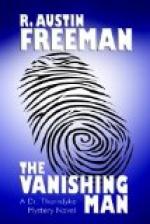“Then there was the fact that all the bones were quite free from adipocere. Now, if an arm or a thigh should be deposited in water and left undisturbed to decay, it is certain that large masses of adipocere would be formed. Probably more than half of the flesh would be converted into this substance. The absence of adipocere therefore proved that the bulk of the flesh had disappeared or been removed from the bones before they were deposited in the pond. That, in fact, it was not a body, but a skeleton, that had been deposited.
“But what kind of skeleton? If it was the recent skeleton of a murdered man, then the bones had been carefully stripped of flesh so as to leave the ligaments intact. But this was highly improbable; for there could be no object in preserving the ligaments. And the absence of scratches was against this view.
“Then they did not appear to be graveyard bones. The collection was too complete. It is very rare to find a graveyard skeleton of which many of the small bones are not missing. And such bones are usually more or less weathered and friable.
“They did not appear to be bones such as may be bought at an osteological dealer’s, for these usually have perforations to admit the macerating fluid to the marrow cavities. Dealers’ bones, too, are very seldom all from the same body; and the small bones of the hand are drilled with holes to enable them to be strung on catgut.
“They were not dissecting-room bones, as there was no trace of red-lead in the openings for the nutrient arteries.
“What the appearances did suggest was that these were parts of a body which had decayed in a very dry atmosphere (in which no adipocere would be formed), and which had been pulled or broken apart. Also that the ligaments which held the body—or rather skeleton—together were brittle and friable, as suggested by the detached hand, which had probably broken off accidentally. But the only kind of body that completely answers this description is an Egyptian mummy. A mummy, it is true, has been more or less preserved; but on exposure to the air of such a climate as ours it perishes rapidly, the ligaments being the last of the soft parts to disappear.
“The hypothesis that these bones were parts of a mummy naturally suggested Mr. Jellicoe. If he had murdered John Bellingham and concealed his body in the mummy-case, he would have a spare mummy on his hands, and that mummy would have been exposed to the air and to somewhat rough handling.
“A very interesting circumstance connected with these remains was that the ring finger was missing. Now, fingers have on sundry occasions been detached from dead hands for the sake of the rings on them. But in such cases the object has been to secure a valuable ring uninjured. If this hand was the hand of John Bellingham, there was no such object. The purpose was to prevent identification; and that purpose would have been more easily, and much more completely, achieved by sacrificing the ring, by filing through it or breaking it off the finger. The appearances, therefore, did not quite agree with the apparent purpose.




